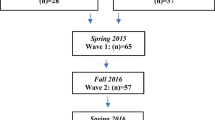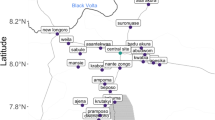Abstract
Background
Indoor air pollution is associated with adverse health effects; however, few studies exist studying indoor air pollution on the Navajo Nation in the southwest U.S., a community with high rates of respiratory disease.
Methods
Indoor PM2.5 concentration was evaluated in 26 homes on the Navajo Nation using real-time PM2.5 monitors. Household risk factors and daily activities were evaluated with three metrics of indoor PM2.5: time-weighted average (TWA), 90th percentile of concentration, and daily minutes exceeding 100 μg/m3. A questionnaire and recall sheet were used to record baseline household characteristics and daily activities.
Results
The median TWA, 90th percentile, and daily minutes exceeding 100 μg/m3 were 7.9 μg/m3, 14.0 μg/m3, and 17 min, respectively. TWAs tended to be higher in autumn and in houses that used fuel the previous day. Other characteristics associated with elevated PM exposure in all metrics included overcrowded houses, nonmobile houses, and houses with current smokers, pets, and longer cooking time.
Conclusions
Some residents of the Navajo Nation have higher risk of exposure to indoor air pollution by Environmental Protection Agency (EPA) standards. Efforts to identify the causes and associations with adverse health effects are needed to ensure that exposure to risks and possible health impacts are mitigated.


Similar content being viewed by others
References
Groom AV, Hennessy TW, Singleton RJ, Butler JC, Holve S, Cheek JE. Pneumonia and influenza mortality among American Indian and Alaska Native people, 1990-2009. Am J Public Health. 2014;104:S460–9.
Weinert BA, Edmonson MB. Hospitalizations at nonfederal facilities for lower respiratory tract infection in American Indian and Alaska Native Children younger than 5 years of age, 1997-2012. J Pediatr. 2016;175:33–9.e4.
Singleton RJ, Holman RC, Folkema AM, Wenger JD, Steiner CA, Redd JT. Trends in lower respiratory tract infection hospitalizations among American Indian/Alaska Native children and the general US child population. J Pediatr. 2012;161:296–302.e2.
Foote EM, Singleton RJ, Holman RC, Seeman SM, Steiner CA, Bartholomew M, et al. Lower respiratory tract infection hospitalizations among American Indian/Alaska Native children and the general United States child population. Int J Circumpolar Health. 2015;74:29256.
Lowe AA, Bender B, Liu AH, Solomon T, Kobernick A, Morgan W, et al. Environmental concerns for children with asthma on the Navajo Nation. Ann Am Thorac Soc. 2018;15:745–53.
Bunnell JE, Garcia LV, Furst JM, Lerch H, Olea RA, Suitt SE, et al. Navajo coal combustion and respiratory health near Shiprock, New Mexico. J Environ Public Health. 2010;2010:260525.
Bonjour S, Adair-Rohani H, Wolf J, Bruce NG, Mehta S, Pruss-Ustun A, et al. Solid fuel use for household cooking: country and regional estimates for 1980-2010. Environ Health Perspect. 2013;121:784–90.
Singleton R, Salkoski AJ, Bulkow L, Fish C, Dobson J, Albertson L, et al. Housing characteristics and indoor air quality in households of Alaska Native children with chronic lung conditions. Indoor Air. 2017;27:478–86.
Bell ML. Committee HEIHR. Assessment of the health impacts of particulate matter characteristics. Res Rep. 2012;161:5–38.
Li N, Champion WM, Imam J, Sidhu D, Salazar JR, Majestic BJ, et al. Evaluation of cellular effects of fine particulate matter from combustion of solid fuels used for indoor heating on the Navajo Nation using a stratified oxidative stress response model. Atmos Environ. 2018;182:87–96.
Triche EW, Belanger K, Beckett W, Bracken MB, Holford TR, Gent J, et al. Infant respiratory symptoms associated with indoor heating sources. Am J Respir Crit Care Med 2002;166:1105–11.
Robin LF, Less PS, Winget M, Steinhoff M, Moulton LH, Santosham M, et al. Wood-burning stoves and lower respiratory illnesses in Navajo children. Pediatr Infect Dis J. 1996;15:859–65.
Pindus N, Kingsley T, Biess J, Levy D, Simington J, Hayes C. Housing Needs of American Indians and Alaska Natives in Tribal Areas: A Report from the Assessment of American Indian, Alaska Native, and Native Hawaiian Housing Needs: Executive Summary (January 2017). U.S. Department of Housing and Urban Development, Office of Policy Development and Research, January 2017, Available at SSRN: https://ssrn.com/abstract=3055776 or https://doi.org/10.2139/ssrn.3055776.
Martell BN, Garrett BE, Caraballo RS. Disparities in Adult Cigarette Smoking — United States, 2002–2005 and 2010–2013. MMWR Morb Mortal Wkly Rep. 2016;65:753–8. https://doi.org/10.15585/mmwr.mm6530a1.
Indian Health Service. Shiprock—Northern Navajo Medical Center. 2021. https://www.ihs.gov/navajo/healthcarefacilities/shiprock/.
Nair H, Nokes DJ, Gessner BD, Dherani M, Madhi SA, Singleton RJ, et al. Global burden of acute lower respiratory infections due to respiratory syncytial virus in young children: a systematic review and meta-analysis. Lancet. 2010;375:1545–55.
World Health Organization Occupational and Environmental Health Team. WHO Air quality guidelines for particulate matter, ozone, nitrogen dioxide and sulfur dioxide: global update 2005: summary of risk assessment. Geneva, Switzerland.: World Health Organization; 2006.
Gurley ES, Salje H, Homaira N, Ram PK, Haque R, Petri WA Jr, et al. Seasonal concentrations and determinants of indoor particulate matter in a low-income community in Dhaka, Bangladesh. Environ Res. 2013;121:11–6.
Burke JM, Zufall MJ, Ozkaynak H. A population exposure model for particulate matter: case study results for PM2.5 in Philadelphia, PA. J Expo Anal Environ Epidemiol. 2001;11:470–89.
Chen C, Zeger S, Breysse P, Katz J, Checkley W, Curriero FC, et al. Estimating Indoor PM2.5 and CO Concentrations in Households in Southern Nepal: The Nepal Cookstove Intervention Trials. PloS ONE. 2016;11:e0157984.
Gurley ES, Homaira N, Salje H, Ram PK, Haque R, Petri W, et al. Indoor exposure to particulate matter and the incidence of acute lower respiratory infections among children: a birth cohort study in urban Bangladesh. Indoor Air 2013;23:379–86.
Paulin LM, Williams D, Oberweiser C, Diette GB, Breysse PN, McCormack MM, et al. Indoor air quality in Central Appalachia Homes impacted by wood and coal use. J Environ Prot. 2013;4:67–71.
Ward T, Palmer C, Bergauff M, Hooper K, Noonan C. Results of a residential indoor PM2.5 sampling program before and after a woodstove changeout. Indoor Air. 2008;18:408–15.
Semmens EO, Noonan CW, Allen RW, Weiler EC, Ward TJ. Indoor particulate matter in rural, wood stove heated homes. Environ Res. 2015;138:93–100.
Breysse PN, Buckley TJ, Williams D, Beck CM, Jo SJ, Merriman B, et al. Indoor exposures to air pollutants and allergens in the homes of asthmatic children in inner-city Baltimore. Environ Res. 2005;98:167–76.
Wang Z, Calderon L, Patton AP, Sorensen Allacci M, Senick J, Wener R, et al. Comparison of real-time instruments and gravimetric method when measuring particulate matter in a residential building. J Air Waste Manag Assoc. 2016;66:1109–20.
Stuber J, Galea S, Link BG. Stigma and smoking: the consequences of our good intentions. Soc Serv Rev. 2009;83:585–609.
Acknowledgements
We are indebted to the Navajo community members who participated in this research and to the Navajo Nation IRB for their support. We gratefully acknowledge the nurses and research program assistants at Johns Hopkins University Center for Native American Health for work on the data collection and air monitoring. Any use of trade, product, or firm names is for descriptive purposes only and does not imply endorsement by the U.S. Government.
Funding
The work on this study was co-funded by The Johns Hopkins Center for American Indian Health and the United States Geological Survey.
Author information
Authors and Affiliations
Contributions
NJ—conducted the main analyses and interpreted the results. She also contributed to writing the paper. AMR—provided expert advice on the interpretation of the results and provided feedback on the publication. RW—contributed to writing the protocol, extracting the data, and provided feedback on the report. LC—provide expert advice on the content matter and provided feedback on the report. JEB—contributed to writing the protocol and interpreting the results and provided feedback on the report. BO—contributed to writing the protocol and interpreting the result and provided feedback on the report. RR—contributed to writing the protocol and provided feedback on the report. MS—contributed the writing the protocol and provided feedback on the report. LLH—provided feedback on the report and data analysis. KLO—contributed to the study design, protocol writing and study conduct.
Corresponding author
Ethics declarations
Competing interests
The authors declare no competing interests.
Additional information
Publisher’s note Springer Nature remains neutral with regard to jurisdictional claims in published maps and institutional affiliations.
Supplementary information
Rights and permissions
About this article
Cite this article
Ji, N., Rule, A.M., Weatherholtz, R. et al. Evaluation of indoor PM2.5 concentrations in a Native American Community: a pilot study. J Expo Sci Environ Epidemiol 32, 554–562 (2022). https://doi.org/10.1038/s41370-021-00373-x
Received:
Revised:
Accepted:
Published:
Issue Date:
DOI: https://doi.org/10.1038/s41370-021-00373-x
- Springer Nature America, Inc.




